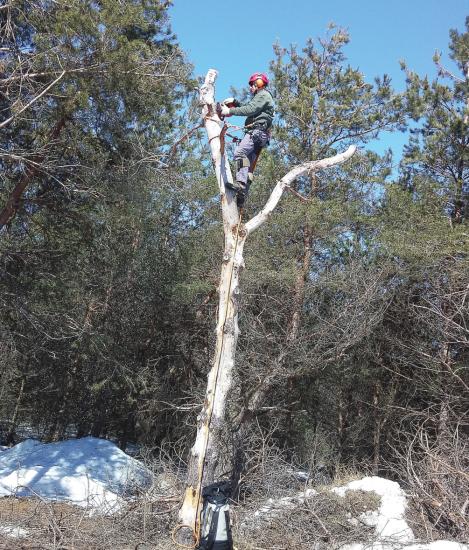All About Arborists
Oct. 1, 2015

Ann Arbor, sitting under the arbor, Arbor Drugs, arbor knots and arboretums. You probably know what all of these are, but what exactly is an arborist?
Bo Burke is a certified consulting arborist and treeworker/climbing specialist from Cedar. Ben Veling is also a certified arborist and owner of Timberwolf Tree Care in Harbor Springs. As they’re both experts on this very topic, we got the scoop from them.
WHAT IS AN ARBORIST?
“Arborists care for trees through disease diagnosis, treatment and prevention, plus fertilization, trimming and removal,” Veling said.
Burke is mostly in agreement, but said that, on occasion, people can use the term arborist a little too loosely.
“Real certified arborists have to be educated,” he said. “We have to be able to identify trees and their diseases, diagnose them and know how to treat them. Arborists don’t just chop trees down; we work to preserve trees.”
WHAT DOES IT TAKE TO BE AN ARBORIST?
“A lot of tree cutters call themselves arborists because you can make a lot of money removing trees,” Burke said, “but real certified arborists have to be educated. We take an extensive test dealing with all facets of our career — biology, safety, removal, all the areas of horticulture — and you have to pass that test before you can become an arborist.”
In addition to his main arborist certification, Burke is also certified as a tree-climbing specialist. He climbs trees by throwing a rope into the branches to ascend, which he calls “installing” the rope from the ground.
He explained that many arborists climb trees with spikes on their shoes, but this damages the tree’s growing system, which means the tree has to work to repair itself, so he won’t use spikes in his work. Burke’s second certification also means he has extra training in aerial rescue, first aid and CPR.
“When we’re working in crews, you need to have someone certified in first aid,” he said. “Sometimes dangerous things happen, so it’s a must.” Veling has a degree in commercial horticulture and more than 250 hours of training in arboriculture.
“To maintain my certification, I have to have an additional 60 hours every three years,” he explained. “My official title is Board Certified Master Arborist.”
SO WHAT EXACTLY DO ARBORISTS DO?
An arborist’s work is seasonal and, while it might seem surprising, they actually don’t take winters off.
“Traditionally, a lot of our disease and pest management starts early in the season, trying to prevent or contain outbreaks,” Veling said. “As summer progresses, we do more trimming and removal. Fertilizing is pretty consistent when temperatures are above freezing. Trimming oak trees should be done after frost, during the winter months.” Burke added that he, too, works throughout the winter pruning oak trees. “You actually shouldn’t prune oaks at all in spring or summer,” he explained. “When you prune an oak, the sap from pruning attracts a certain beetle that leaves a fungus in the tree that can kill it in four to six weeks. So you wait until it’s cold enough that those beetles are gone.”
Burke also cautioned that when spring arrives and people want to trim trees for aesthetics, they often cut too much of the tree back. That’s another job better left to an arborist.
“Those leaves carry out photosynthesis and that’s how the trees eat,” he said. “If you cut off too many branches, you’re taking the tree’s food factory away.”
WHAT ARE SOME OF THE CHALLENGES OF THIS JOB?
“One big challenge is poor quality previous care, which often leads to dangerous trees,” Veling said. “Another are consumers that have been misled by poorly trained or untrained tree companies in the past.”
Burke finds more challenges in the trees themselves.
“The trees are quite tall here,” he said. “We have a damp and nutritious environment and these trees are pretty hardy. I had to get a longer rope when I started working in northern Michigan!”
Veling’s crew works in all kinds of weather to manage the health of a wide range of homeowner trees, as well as the trees of more than a dozen private orchards.
Burke said that sometimes his arborist duties even extend beyond the trees themselves.
“I rescue cats. I’ve put baby owls back in trees and helped organizations put webcams up in trees, for instance, to observe eagle nests,” he said.
Burke also works with the Leelanau Conservancy as a volunteer arborist and with Rebecca Lessard at Wings of Wonder, where he said he “just helps out Rebecca and the birds however they need me.”
WHAT INSPIRED YOU TO BECOME AN ARBORIST?
Veling has been working with trees since he was 16.
“It started as a summer job and I liked it,” he said.
He got his horticulture degree from Michigan State University and has been working with trees for more than 20 years. He recently became certified in TRAQ (Tree Risk Assessment Qualification) and next plans to become a consulting arborist. When he started, he only had a chainsaw and a pickup truck; now he oversees an entire crew and office in Harbor Springs and still works outdoors.
Burke (ironically a native of Ann Arbor) started his arborist career in his 20s while living in Colorado, where he apprenticed with a tree company in Aspen and worked toward his certifications.
“I’m more of a philosopher,” Burke said. “I’ve always studied nature and plants and had a love for the outdoors. I saw people working in a tree and I thought, wow, I really want to do that.”
After Burke left Colorado, he worked in Chicago as an arborist for the city, taking care of trees in all the major parks, including Lincoln Park and Grant Park. He eventually decided he wanted to live closer to the woods, so he headed north to start his own arborist business.
WHAT DO YOU LIKE ABOUT WORKING AS AN ARBORIST?
Veling puts it simply. “If I do a good job, I will get to be a steward of something that will be here well after I’m gone.”
Burke’s answer is right along the same track. “I like that I can help trees, to make sure they grow for hundreds of years so other people can enjoy them,” he said. “Keeping trees healthy keeps the planet healthy. I mean, that’s the oxygen we breathe. When I’m working on trees, I feel a thank you coming from nature.”
Sometimes Burke goes back to trees he’s worked on, just to see how they’re doing.
“We arborists are in the care physician business, really. They may not be human beings, but they’re alive. So when I find out they’re doing well, that’s enough,” he said. “That makes me happy.”
Bo Burke: boknowstrees.com, (231) 835-1111, bo@boknowstrees.com
Ben Veling: timberwolftreecare.com, (231) 526- 6738, info@timberwolftreecare.com
Trending

Springtime Jazz with NMC
Award-winning vibraphonist Jim Cooper has been playing the vibraphone for over 45 years and has performed with jazz artist... Read More >>
Dark Skies and Bright Stars
You may know Emmet County is home to Headlands International Dark Sky Park, where uninterrupted Lake Michigan shoreline is... Read More >>
Community Impact Market
No need to drive through the orange barrels this weekend: Many of your favorite businesses from Traverse City’s majo... Read More >>


